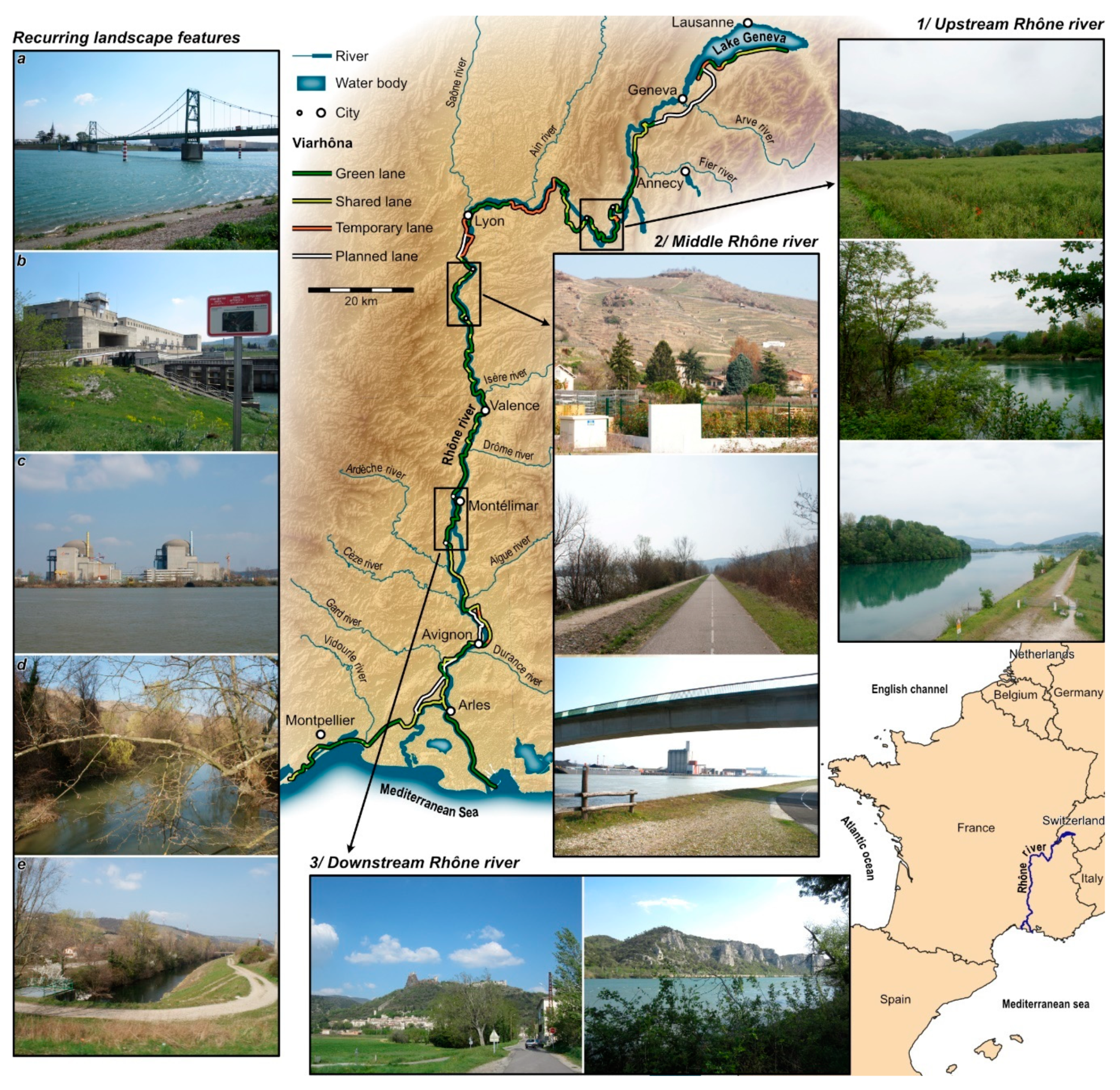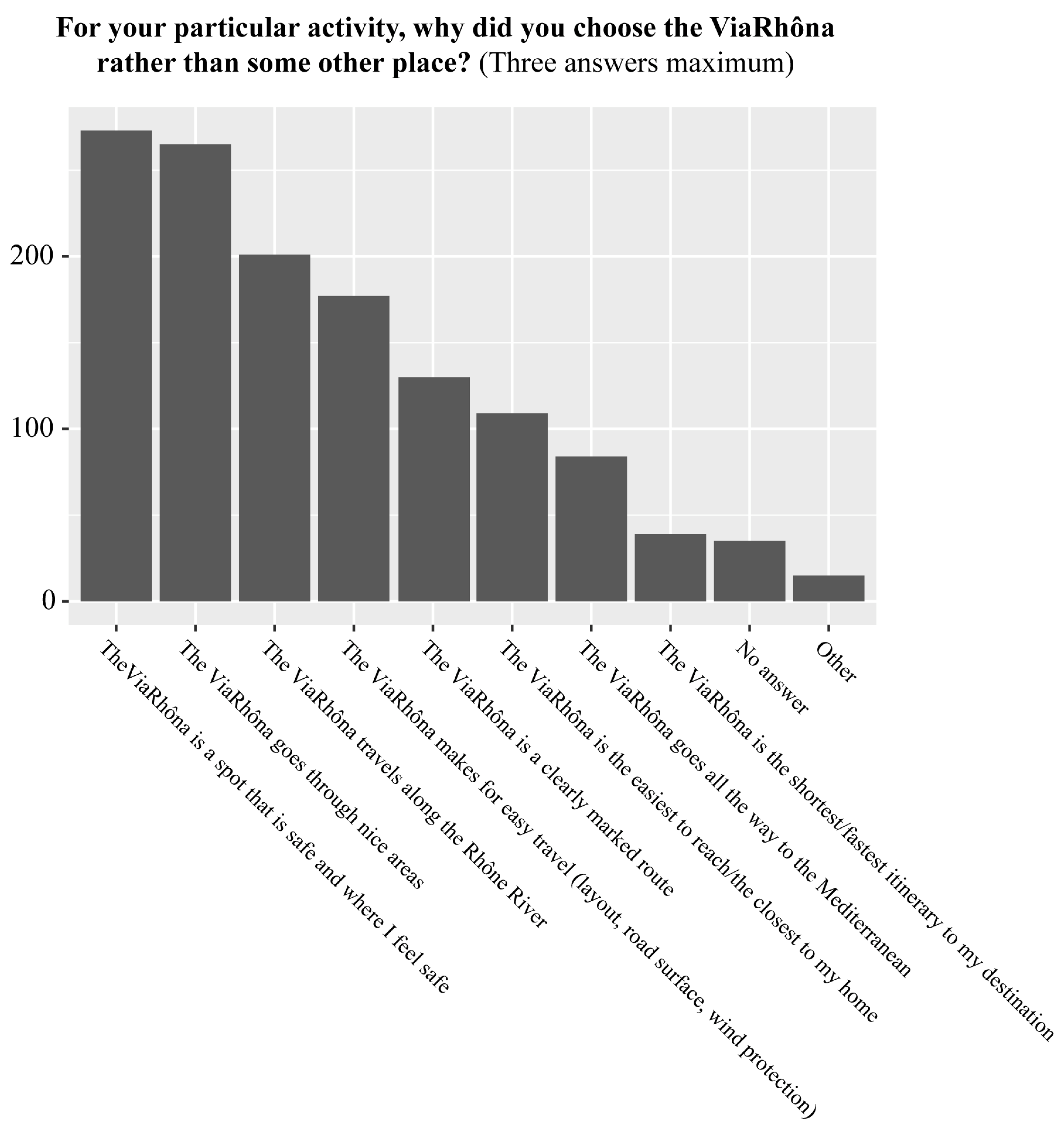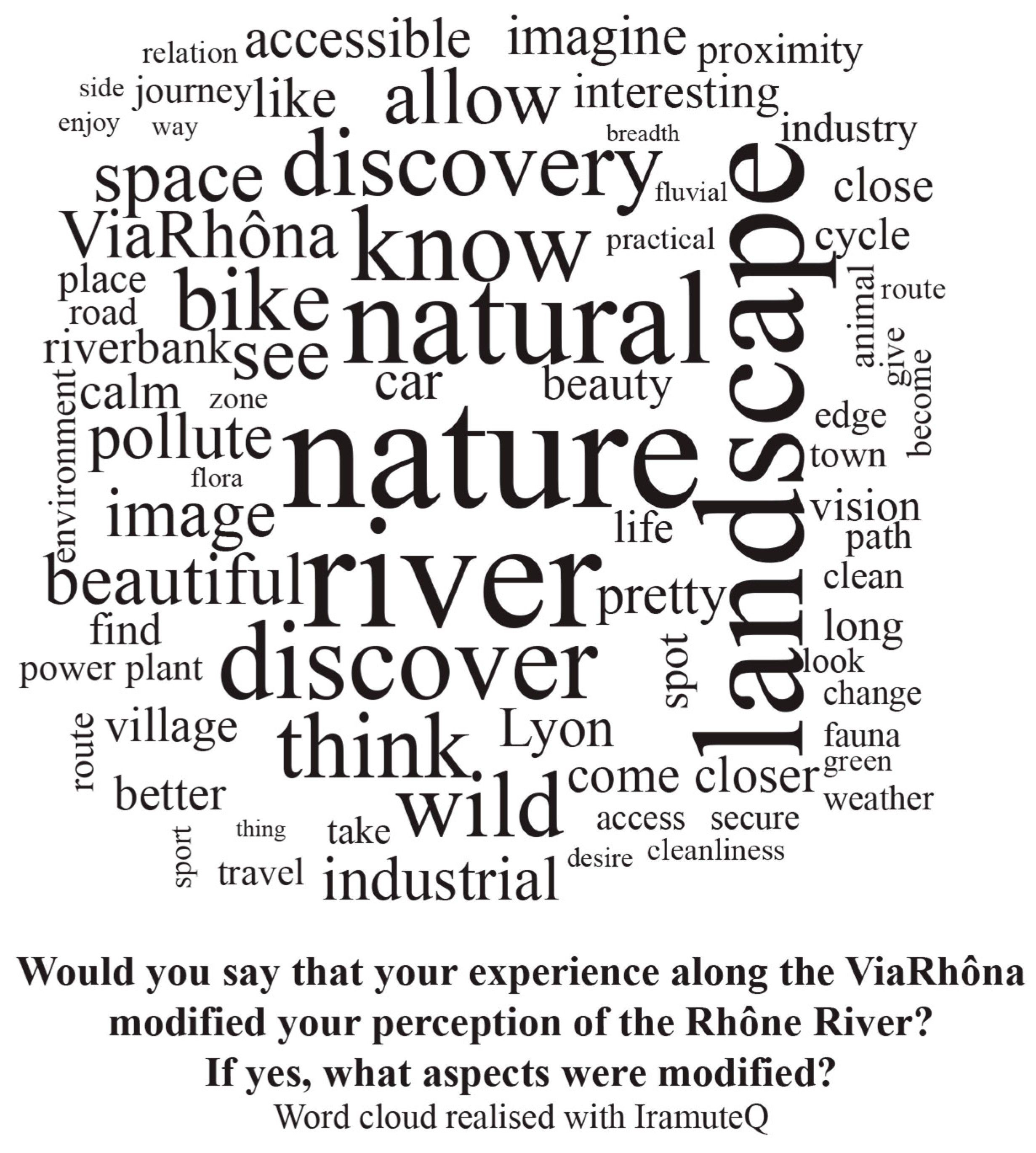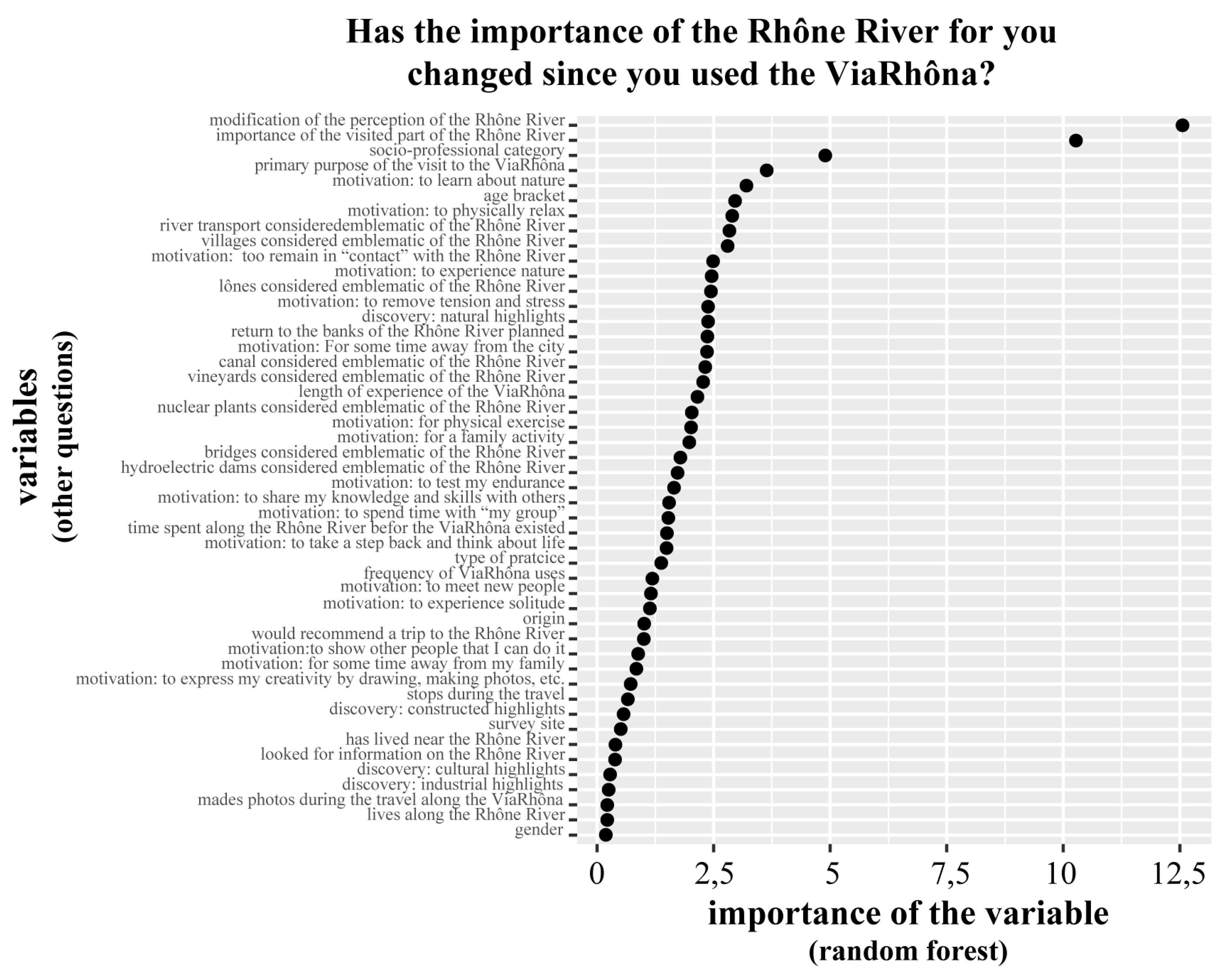Cycling along a River: New Access, New Values?
Abstract
1. Introduction
2. Materials and Methods
2.1. Study Site
2.2. Data Collection
2.2.1. Semi-Structured Interviews
2.2.2. The Questionnaire
- The first part looked at the activities of the person (type of travel, sectors visited, frequency of activity, and years of practice). Some questions aimed to characterise the motivations of people to use the ViaRhôna using a psychometric scale inspired by the work of Smith and Moore [22], who used this scale to characterise demand for recreational activities and sites.
- The second part examined the perception of Rhône landscapes by the respondents and their degree of familiarity with them. A photo-questionnaire depicting diverse river landscapes [23] was used. Participants were asked to assess, using a visual scale, the degree to which 16 landscapes were emblematic of the Rhône River. An open question was also asked in order to assess their knowledge on those landscapes (and notably whether they were capable of naming it). Eight categories of landscapes (each represented by two photographs) were selected in as much as they were deemed emblematic of the Rhône by stakeholders in the Rhône Plan. The sectors seen as emblematic by stakeholders were identified using qualitative analysis of interviews carried out with those persons during another part of the research project (their opinions were gathered in a previous phase of the scientific project).
- The third part studied the impact of the cycle route on the relationship of the respondents with the river, in particular in terms of the image of and the values attributed to the river. To characterise those values, we used the typology devised by Brown and Raymond [24].
- The fourth part aimed to characterise the respondent sociologically and based on where the person lived.
2.3. Data Analysis
3. Results
3.1. The Surveyed Population
3.2. Survey Results
3.2.1. The River Environment and Uses as Sources of Motivation
3.2.2. More Frequent Use, New Activities
3.2.3. A Modified Perceived Image of the River
“Yes, I found that there was much more... There was more nature, more real countryside than I imagined after having travelled on the highway so many times.”(Pierre, 53, Swiss, itinerant cyclist and sports cyclist)
“Interviewer: What constitutes the identity or the specificity of these different Rhône landscapes? Interviewee: In this section, it is the use made of the river and of its force. The hydroelectric installations, the nuclear plants are not the same, but they do use the water to cool the reactors. It is the use made of the river.”(Emmanuelle, 42, French from the region, itinerant cyclist)
“You can take the time, you have the time to really experience where you are, time that you do not necessarily have in a car. In one hour in a car, you can travel 100 km, but that is not the case on a bicycle. You have the time to take in the ambience, the noises, the landscapes.”(Élise, 30, French, itinerant cyclist)
3.2.4. Greater Value
3.2.5. Only Slight Changes in Knowledge of the River
4. Discussion
4.1. The ViaRhôna, a Project that Modifies the Perceived Images and Values of the River
4.2. Users “Selected” by the Project
4.3. The Limits to Attractiveness
5. Conclusions
Author Contributions
Funding
Conflicts of Interest
References
- Purcell, A.T.; Lamb, R.J.; Mainardi, P.E.; Falchero, S. Preference or preferences for landscape? J. Environ. Psychol. 1994, 14, 195–209. [Google Scholar] [CrossRef]
- Gobster, P.H.; Nassauer, J.I.; Daniel, T.C.; Fry, G. The shared landscape: What does aesthetics have to do with ecology? Landsc. Ecol. 2007, 22, 959–972. [Google Scholar] [CrossRef]
- Nassauer, J.I. The appearance of ecological systems as a matter of policy. Landsc. Ecol. 1992, 6, 239–250. [Google Scholar] [CrossRef]
- Desfor, G.; Laidley, J.; Stevens, Q.; Schubert, D. (Eds.) Transforming Urban Waterfronts: Fixity and Flow; Routledge: London, UK, 2013. [Google Scholar]
- Norcliffe, G.; Bassett, K.; Hoare, T. The emergence of postmodernism on the urban waterfront: Geographical perspectives on changing relationships. J Transp. Geogr. 1996, 4, 123–134. [Google Scholar] [CrossRef]
- Wrenn, D.M.; Casazza, J.; Smart, E. Urban Waterfront Development; Urban Land Institute: Washington, DC, USA, 1983. [Google Scholar]
- Baron-Yellès, N. Recréer la Nature: Écologie, Paysage et Société au Marais d’Orx; Presses de l’École Normale Supérieure: Paris, France, 2000. [Google Scholar]
- Lefebvre, S.; Trudeau, M. La Route verte, un circuit touristique? Téoros Rev. Rech. Tour 2003, 22, 46–51. [Google Scholar]
- Lumsdon, L.; Downward, P.; Cope, A. Monitoring of cycle tourism on long distance trails: The North Sea Cycle Route. J. Transp. Geogr. 2004, 12, 13–22. [Google Scholar] [CrossRef]
- Meschik, M. Sustainable Cycle Tourism along the Danube Cycle Route in Austria. Tour. Plan. Dev. 2012, 9, 41–56. [Google Scholar] [CrossRef]
- Davodeau, H.; Pordoy, C.; Montembault, D.; Barraud, R.; Carcaud, N. Patrimonialiser la nature et les paysages: Contradictions et paradoxes au sujet des épis de la Loire armoricaine. Espace Geogr. 2013, 42, 241–253. [Google Scholar] [CrossRef]
- Giovannini, A.; Malucelli, F.; Nonato, M. Cycle-tourist network design. Transp. Res. Procedia 2017, 22, 154–163. [Google Scholar] [CrossRef]
- Deenihan, G.; Caulfield, B.; O’Dwyer, D. Measuring the success of the Great Western Greenway in Ireland. Tour. Manag. Perspect. 2013, 7, 73–82. [Google Scholar] [CrossRef]
- Dickinson, J.E.; Robbins, D. Other People, Other Times and Special Places: A Social Representations Perspective of Cycling in a Tourism Destination. Tour. Hosp. Plan. Dev. 2009, 6, 69–85. [Google Scholar] [CrossRef]
- Downward, P.; Lumsdon, L.; Weston, R. Visitor Expenditure: The Case of Cycle Recreation and Tourism. J. Sport Tour. 2009, 14, 25–42. [Google Scholar] [CrossRef]
- Reckwitz, A. Toward a Theory of Social Practices: A Development in Culturalist Theorizing. Eur. J. Soc Theory 2002, 5, 243–263. [Google Scholar] [CrossRef]
- Shove, E.; Pantzar, M.; Watson, M. The Dynamics of Social Practice: Everyday Life and How it Changes; Sage: London, UK, 2012. [Google Scholar]
- Serrão, A.V.; Reker, M. Philosophy of Landscape: Think, Walk, Act; Centre for Philosophy at the University of Lisbon: Lisbon, Portugal, 2019. [Google Scholar]
- Cottet, M. Caractériser les Valeurs Environnementales au Cours du Temps: Une étape Indispensable à la Gestion des Patrimoines Naturels: Le cas de la Restauration des Bras Morts de l’Ain et du Rhône. Available online: http://journals.openedition.org/vertigo/13558 (accessed on 27 September 2019).
- Peyrard, O.; Prost, B. Le difficile éveil du Rhône à la civilisation des loisirs / The difficult Awakening of the Rhône to a leisure society. Géocarrefour 1997, 72, 57–65. [Google Scholar] [CrossRef]
- Béthemont, J.; Bravard, J.P. Pour Saluer le Rhône; Libel: Paris, France, 2016. [Google Scholar]
- Smith, J.W.; Moore, R.L. Social-Psychological Factors Influencing Recreation Demand: Evidence From Two Recreational Rivers. Environ. Behav. 2012, 45, 821–850. [Google Scholar] [CrossRef]
- Le Lay, Y.F.; Cottet, M.; Piégay, H.; Rivière-Honegger, A. Ground Imagery and Environmental Perception: Using Photo-questionnaires to Evaluate River Management Strategies; Carbonneau, P., Piégay, H., Eds.; John Wiley and Sons: Hoboken, NJ, USA, 2012; pp. 405–426. [Google Scholar]
- Brown, G.; Raymond, C. The relationship between place attachment and landscape values: Toward mapping place attachment. Appl. Geogr. 2007, 27, 89–111. [Google Scholar] [CrossRef]
- Paillé, P.; Mucchielli, A. L’analyse Qualitative en Sciences Humaines et Sociales; Armand Colin: Malakoff, France, 2019. [Google Scholar]
- Liaw, A.; Wiener, M. Classification and Regression by random Forest. R News 2002, 2, 18–22. [Google Scholar]
- Lebart, L.; Salem, A. Statistique Textuelle; Dunod: Paris, France, 1994. [Google Scholar]
- Ratinaud, P. Iramuteq: Interface de R pour les Analyses Multidimensionnelles de Textes et de Questionnaires. Available online: http://www.iramuteq.org/documentation/fichiers/Pas%20a%20Pas%20IRAMUTEQ_0.7alpha2.pdf (accessed on 13 April 2017).
- Crossely, S.; Salsbury, T.; McNamara, D. Validating Lexical Measures Using Human Scores of Lexical Proficiency; Jarvis, S., Daller, M., Eds.; John Benjamins Publishing Company: Amsterdam, The Netherlands, 2003. [Google Scholar]
- Garnier, B.; Guérin-Pace, F. Appliquer les Méthodes de la Statistique Textuelle; CePeD: Paris, France, 2010. [Google Scholar]
- Mercat, N. Étude de Fréquentation et d’impact Economique de la ViaRhôna en 2017. Rapport Final; Indigo–Symetris: Région Provence-Alpes-Côte d’Azur, France, 2018. [Google Scholar]
- Kondolf, G.M.; Pinto, P.J. The social connectivity of urban rivers. Geomorphology 2017, 277, 182–196. [Google Scholar] [CrossRef]
- Gobster, P.H. Visions of nature: Conflict and compatibility in urban park restoration. Landsc. Urban Plan. 2001, 56, 35–51. [Google Scholar] [CrossRef]
- Williams, D.; Vaske, J. The Measurement of Place Attachment: Validity and Generalizability of a Psychometric Approach. For. Sci. 2003, 49, 830–840. [Google Scholar]
- Hailu, G.; Boxall, P.C.; McFarlane, B.L. The influence of place attachment on recreation demand. J. Econ. Psychol. 2005, 26, 581–598. [Google Scholar] [CrossRef]
- Fleury, L.; Clark, T.N. Sociology of Culture and Cultural Practices: The Transformative Power of Institutions; Lexington Books: Lanham, MD, USA, 2014. [Google Scholar]
- Swartz, D. Culture & Power: The Sociology of Pierre Bourdieu; Chicago Press: Chicago, IL, USA, 2003. [Google Scholar]
- Nofre, J.; Giordano, E.; Eldridge, A.; Martins, J.C.; Sequera, J. Tourism, nightlife and planning: Challenges and opportunities for community liveability in La Barceloneta. Tour. Geogr. 2018, 20, 377–396. [Google Scholar] [CrossRef]
- Novy, J.; Colomb, C. Urban tourism and its discontents. An introduction. In Protest Resist Tour City; Colomb, C., Novy, J., Eds.; Routledge: New York, NY, USA, 2016; pp. 1–30. [Google Scholar]
- Depraz, S.; Laslaz, L. Conflicts, Acceptance Problems and Participative Policies in the National Parks of the French Alps. Eco.Mont. J. Prot. Mt. Areas Res. Manag. 2017, 9, 46–56. [Google Scholar] [CrossRef]
- Cadoret, A. L’attachement aux lieux dans les conflits liés à l’environnement sur le littoral: Une ressource pour leur régulation. Place attachment in environmental conflicts on coastal zone: A resource for their resolution. VertigO 2017, 17. Available online: http://journals.openedition.org/vertigo/18436 (accessed on 27 September 2019). [CrossRef]
- Perkumienė, D.; Pranskūnienė, R. Overtourism: Between the Right to Travel and Residents’ Rights. Sustainability 2019, 11, 2138. [Google Scholar] [CrossRef]
- Soja, E.W. Seeking Spatial Justice; Univ. of Minnesota Press: Minneapolis, MN, USA, 2010. [Google Scholar]




| Upstream: Belley to Groslée, via Saint-Genix-sur-Guiers | Midsection: Vienne to Sablons, via Condrieu | Downstream: Rochemaure to Bourg-Saint-Andéol | |
|---|---|---|---|
| Link between the ViaRhôna and the river | Constant proximity to the Rhône (alternating between the old Rhône and the channelised Rhône), with the exception of a few detours on country roads or behind the dike. | Occasionally directly on the bank of the channelised Rhône, but most often behind the dike (rather monotonous in the southern section). A few sections farther from the river (vegetable farms, wooded areas). | One half along the Rhône bypass canal, then directly along the river. A few sections on more distant country roads or on paths through wooded areas. |
| Main landscape features | Natural landscapes: cliffs, wooded areas, wetlands. Farming landscapes: vegetable farms and orchards. Landscapes blocked by far-off mountains (Alps and Jura). | Farming landscapes: orchards, vegetable farms and terraced vineyards. Industrial landscapes. Open, hilly landscapes. | Natural landscapes: wooded areas and cliffs. Industrial landscapes in a few spots. Farming landscapes. Open landscapes with cliffs and hills in a few spots. |
| Industrial landscapes | In some places: quarries, hydroelectric plants. | In many places: hydroelectric plants, nuclear power plants, chemical factories, warehouses. | In some places: cement plant, hydroelectric plants. |
| Urban landscapes | No urban landscapes (and few villages entered). | Mostly urban and peri-urban landscapes. | Villages perched above the river in a few spots. |
| Itinerant Cyclists | Day Trippers | Utilitarian Users | Sports Cyclists | Total | |
|---|---|---|---|---|---|
| Median age (years) | 46.4 | 56.4 | 42.4 | 51.7 | 51.6 |
| Men (%) | 55.7 | 54.9 | 57.9 | 70.3 | 57.3 |
| Live along the Rhône (%) | 14.9 | 63.2 | 60.1 | 58.3 | 44.2 |
| Tourists (%) | 87.3 | 24.4 | 24.3 | 32.1 | 46.4 |
| Retired (%) | 20.9 | 45.3 | 22.9 | 40 | 34.7 |
| School children and students (%) | 10.4 | 5.5 | 14.3 | 11.3 | 8.7 |
| Executive personnel (%) | 30.7 | 19.4 | 14.3 | 17.5 | 22.6 |
| Technicians and equivalent staff (%) | 23.3 | 12.9 | 22.9 | 13.8 | 17.2 |
| Labourers (%) | 1.2 | 1 | 5.1 | 3.8 | 2 |
| Locals (%) | 5.2 | 54.5 | 57.9 | 52.4 | 37.9 |
| Regionals (%) | 14.4 | 20.9 | 21.1 | 19.1 | 18.5 |
| French (%) | 29.3 | 12.3 | 10.5 | 11.9 | 17.9 |
| Foreign (%) | 51.1 | 10.9 | 10.5 | 16.6 | 25.7 |
Publisher’s Note: MDPI stays neutral with regard to jurisdictional claims in published maps and institutional affiliations. |
© 2020 by the authors. Licensee MDPI, Basel, Switzerland. This article is an open access article distributed under the terms and conditions of the Creative Commons Attribution (CC BY) license (http://creativecommons.org/licenses/by/4.0/).
Share and Cite
Adam, M.; Cottet, M.; Morardet, S.; Vaudor, L.; Coussout, L.; Rivière-Honegger, A. Cycling along a River: New Access, New Values? Sustainability 2020, 12, 9311. https://doi.org/10.3390/su12229311
Adam M, Cottet M, Morardet S, Vaudor L, Coussout L, Rivière-Honegger A. Cycling along a River: New Access, New Values? Sustainability. 2020; 12(22):9311. https://doi.org/10.3390/su12229311
Chicago/Turabian StyleAdam, Matthieu, Marylise Cottet, Sylvie Morardet, Lise Vaudor, Laure Coussout, and Anne Rivière-Honegger. 2020. "Cycling along a River: New Access, New Values?" Sustainability 12, no. 22: 9311. https://doi.org/10.3390/su12229311
APA StyleAdam, M., Cottet, M., Morardet, S., Vaudor, L., Coussout, L., & Rivière-Honegger, A. (2020). Cycling along a River: New Access, New Values? Sustainability, 12(22), 9311. https://doi.org/10.3390/su12229311





